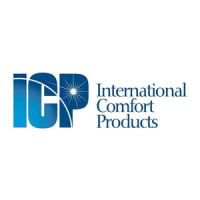
Do you have a question about the ICP NTC5125BKD1 and is the answer not in the manual?
| Brand | ICP |
|---|---|
| Model | NTC5125BKD1 |
| Efficiency | 80% AFUE |
| Stages | Single Stage |
| Heat Exchanger Warranty | 20 Years |
| Unit Warranty | 5 Years |
Understanding safety alerts and symbols in manuals for potential injury.
Definitions of DANGER, WARNING, and CAUTION signal words used with safety alerts.
Only trained personnel should install or service heating equipment due to hazards.
Adherence to national and local safety codes, including NFGC and CSA standards.
Prohibits installation in mobile homes and use as a construction heater.
Covers approved gas type, leak testing, air supply, venting, electrical protection, and detectors.
General safety, detector recommendations, reading manuals, and avoiding water damage.
Warning about frozen pipes and precautions for unattended structures during cold weather.
Guidance on evaluating existing location when replacing a furnace.
Essential steps for proper furnace installation, including leveling and centralization.
Details on mounting, locations, and required clearances for horizontal installations.
Procedure for moving the pressure switch for specific horizontal airflow configurations.
Critical warning about CO risk if combustion and ventilation air is inadequate.
Identifies environments with chemicals requiring outside air for combustion to protect the furnace.
Defines confined spaces and the air supply requirements for appliances within them.
Requirements for sizing and connecting air openings for combustion and ventilation.
Mandates sufficient air for proper combustion and flue gas ventilation via ducts or openings.
Reiterates CO hazard and the need for adequate air infiltration in tight homes.
Details air supply needs for unconfined spaces and homes with tight construction.
Critical warning about CO, fire, and explosion risks from improper venting.
Specific rules for Type B/L vent pipes, chimney connections, and slope for Category I furnaces.
Procedure to verify proper venting and adequate combustion air after installation or appliance changes.
Requirement for a power venter for horizontal sidewall termination of Category I furnaces.
Procedures for inspecting masonry chimneys and selecting the correct vent connector.
Guidelines for interior and exterior chimneys regarding venting configurations.
Step-by-step instructions for installing the optional masonry vent kit.
Ensures correct gas type, input rating, and stable supply pressure for furnace operation.
General guidelines for gas piping installation, including codes, shutoff valves, and materials.
Critical warning about fire, explosion, and CO hazards at high altitudes if not properly adjusted.
Explains altitude adjustments for input rating and the availability of high altitude kits.
Steps to safely disconnect power and gas before accessing and changing orifices.
Procedure for removing old orifices and installing new ones with correct depth.
Steps to ensure all gas connections are leak-free after reassembling the manifold.
Requirements for furnace electrical wiring, grounding, circuit, and conductor sizing.
Guidance on thermostat placement, wiring, and setting the heat anticipator.
Rules for wiring optional accessories like humidifiers or air cleaners.
Critical warning about CO risk from improper duct sealing or cool air over heat exchanger.
Guidelines for connecting ducts, designing air distribution systems, and minimizing noise.
Specific requirements for sealing ducts, installing refrigeration coils, and insulating ducts.
Information on filter types, sizes, rack mounting for different configurations.
Procedures for initial startup and immediate actions for any operational anomalies.
Steps for checking and adjusting gas supply and manifold pressures for optimal performance.
Critical warning about turning off power before changing blower speed taps to prevent shock.
Emphasizes installer's role in selecting correct blower speed taps based on application static pressure.
Recommends annual inspection and servicing by a qualified technician before the heating season.
Routine check for cracks in tubes on the pressure switch during annual maintenance.
